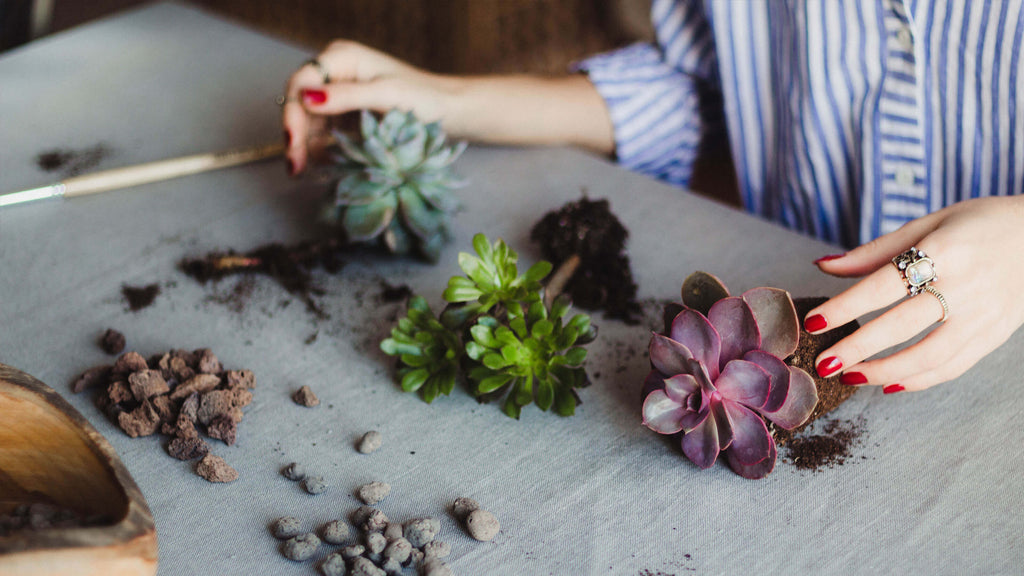WHAT IS A TERRARIUM?
Simply, terrarium is a glass container, chiefly or wholly enclosed, for growing and displaying plants. The main idea behind the terrarium is to create a proper environment for plant growth, however they are often kept as decorative or ornamental items. Because of the different conditions within, terrariums can be classified into two types: closed and open.
Tropical plant varieties, such as mosses, orchids, ferns, and air plants, are generally kept within closed terrariums due to the conditions being similar to the humid and sheltered environment of the tropics.
Open terrariums are better suited to dry plants such as succulents and cactai. Not all plants require or are suited to the moist environment of closed terrariums. For plants adapted to dry climates, open, unsealed terrariums are used to keep the air in the terrarium free from excess moisture. Open terrariums also work well for plants that require more direct sunlight, as closed terrariums can trap too much heat potentially killing any plants inside.
Although it seems like terrariums have only recently become popular, they were actually designed with increasing intricacy and style and have been widely consumed as a decoration for the home since the Victorian age. Today, they became of part of the product design as a dynamic element in the modern home, while creating a tiny eco-system for everyone with a love of nature can easily deal with.
Below, we will explain how to build one of these miniature gardens in a geometric terrarium crafted by us.
PLANTS

The two Echeveria plants are the stars of the show. Tones of cool greens and blues are linked by the red accents on the leaves. In this workshop, The Black Mage Flower provides height at the back of the terrarium. When it grows too big, replace it with smaller pieces.
1. Black Mage Flower
2 Echeveria Perle von Nurnberg
3 Echeveria 'Blue Prince'

Materials You'll Need

To create a terrarium you'll need:
• Pebbles for drainage, ideally around 1 cm in diameter.
• Activated charcoal. Mix in a handful with your pebbles to keep the eco-system sweet and avoid any stagnation and fungi that can occur when there is a lack of drainage.
• Soil, to suit your choice of plants.
• Moss or gravel to dress. As you’ll probably need to use sphagnum, pincushion and sheet moss in fairly large quantities, it is best to buy them from a specialist supplier.
• Natural objects found in your garden to enhance planting ideas.
PLANTING PROCESS
Start by putting 2.5 cm layer of pebbles for drainage, mixed in with a handful of activated charcoal into the base of your chosen container.

And then start filling your container with soil that suits your plants' needs. You can use a long spoon or wear rubber gloves to prevent your hands getting dirty but green thumbs will know that playing with soft, beautiful soil is the fun part of indoor gardening. So go with your hands since you'll be more comfortable with them in next steps, especially when placing the plants.
PREPARING THE PLANT
If the plants you're planning to use are already potted, you may want to get rid of the rootballs. The rootball is the part of the plant that extends into the actual pot. It's made up of roots and soil and often keeps the shape of the pot after it's removed. Remove your plant from its current pot and prune the rootball to expose fresher roots to the soil in your terrarium.

It’s much easier to work out your plant combinations on the table first before planting as you have more room for manoeuvre. After you’ve decided on a design, start placing them in the terrarium. As this container had an opening at the front I planted it up from the back to the front so as not to damage or bruise the plants.

The easiest way to plant in a confined space like this – and to some degree all terrariums – is to use a long-handled spoon to place soil around them.
Finally, use a paintbrush to remove any soil or gravel that had been spilled and as a final touch, dress your terrarium with natural stones, found rustic objects and moss to make it look more like the plant’s natural environment. You should place the terrarium in a cool, bright room, avoiding direct sunlight, which risks glass magnifying the heat and scorching the fleshy leaves. Water these plants very sparingly, hardly at all in winter, and once every two weeks in summer if required.





superb piece of information.
thanks.
www.snemeenovelties.com